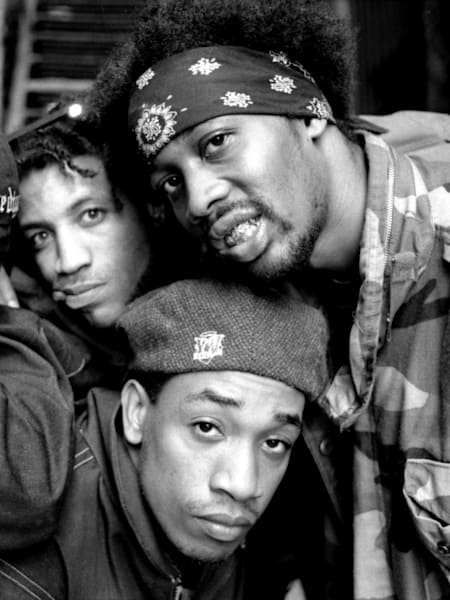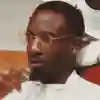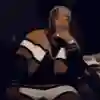If there’s one thing hip-hop fans love more than listening to hip-hop, it’s arguing about hip-hop – and especially what actually defines the genre. KRS One of Boogie Down Productions famously proclaimed "Rap is something you do, hip-hop is something you live" and it remains a useful point to keep in mind. Hip-hop and most of its subgenres can be defined by where an artist is from and what their lifestyle is – as well as sound and subject matter.
The master genre has unfolded in fascinating ways since its birth in the late ‘70s, so here’s an introduction to some the many vibrant styles that have developed since then... Be warned, there's explicit language from here on out!
Backpack
Backpackers were late ‘90s hip-hop obsessives, who rejected the commercialisation of rap and the more polished, allegedly less thought-provoking styles that achieved greater mainstream success. The somewhat contested term refers to a cliché of the fans wearing backpacks to fill with college books, rhyme pads, spray paint or vinyl.
Rawkus was one of the backpacker’s favourite labels. It released classic albums from the likes of Mos Def and Company Flow before committing the ultimate sin and selling themselves to Interscope. Just about everything on Company Flow alumni and future Run The Jewels star El-P’s Def Jux label is also essential, as are the early works of Californian producer Madlib – especially his turn as a sociopathic gangsta aardvark Lord Quas on Quasimoto album The Unseen.
Hear it best in: Mos Def - Mathematics
Boom bap
Boom bap is a reference to a heavy kick drum 'boom' followed by the crisp 'bap' of a snare, usually at a moderate tempo and mixed so high it’s almost impossible to listen without bobbing your head. In the early days, you could fairly claim all hip-hop music was boom bap, even if the term didn’t enter into general circulation until T La Rock’s ad-libbed outro on It’s Yours in 1984. The sound it describes was at the heart of hip-hop – from the earliest breakbeats through the sampling innovations of Marley Marl to the original golden era of New York rap music when the likes of DJ Premier, Large Professor and Pete Rock were making heads snap with classic boom bap.
Hear it best in: Gang Starr – Just To Get A Rep
Cloud rap
A term originally coined in 2010 following the more airy-sounding tracks of self-proclaimed 'Based God' Lil B, cloud rap quickly became the pigeonhole of choice for anyone looking to describe a whole wave of artists who tended to favour abstract atmospheric soundscapes for heavily medicated bedroom introspection over the more traditional hip-hop priority of butt-shaking percussion. Lauded pioneers included producer Clams Casino, Oakland duo Main Attrakionz and A$AP Rocky.
Hear it best in: Main Attraktionz – Chuch
Conscious hip-hop
At its broadest, conscious hip-hop could refer to any rap considered woke by the standards of its time – from Melle Mel’s visions of urban poverty on Grandmaster Flash And The Furious Five’s The Message to J Cole’s musings on addiction in KOD. Most often it’s used to mean rappers whose main focus is raising socio-political awareness. Think KRS–One calling himself ‘The Teacha’ or artists such as Akala, Dead Prez, Talib Kweli and Boots Riley of The Coup being renowned almost as much as activists as they are musicians. More specifically it’s sometimes used as a shorthand for Afrocentric raps which aim to raise black consciousness, from Public Enemy, Paris and X-Clan in the early ‘90s to Kendrick Lamar in the 2010s.
Hear it best in: Blackstar – Definition
Crunk
For a fair while in the ‘90s, the word ‘crunk’ was nothing much more than an odd bit of dirty south slang, meaning to get hyped up or excited. It popped up every now and then on all sorts of records from Outkast’s debut Player’s Ball to Memphis Rap legend Tommy Wright III’s Getting Crunk. In 1997, Lil’ Jon & The Eastside Boyz effectively owned the word forevermore with the release of their debut Get Crunk Who You Wit – The Album. From that point on, crunk meant heavy but often mid-tempo proto-trap club beats with a menacing lean and somebody, preferably Lil’ Jon, screaming ad-libs or chanting slogans like “represent your shit, motherf**ker” and “bounce your ass to the beat while you touch your feet”.
Hear it best in: Lil Jon & The East Side Boyz – Get Low
Drill
Drill was born in Chicago around 2011 and first impacted on a global scale with Chief Keef’s breakthrough anthem I Don’t Like the following year. To all but the most dedicated fans, it’s virtually indistinguishable from trap, musically at least. It’s the same slow boom, the same rattling hi-hat. The difference is mainly about emphasis and attitude. Where trap concerns itself with the scuzzy end of the narcotics industry, drill focuses on the often related but distinct topic of gun violence and gang warfare.
Hear it best in: Chief Keef – I Don’t Like ft. Lil Reese
Emo rap
Though early hip-hop material was often macho or even aggressive in attitude, there’s been tradition from at least as far back as LL Cool J’s I Need Love of rappers showcasing a more sensitive side to their art. But that’s not quite emo rap. In 2008, the massive success of Kanye’s 808s & Heartbreak made a large cultural impact. Then the vulnerable seductions of Drake and sad hedonism of Future normalised a melancholic spirit in rap further. In recent years, hugely popular artists such as Lil Peep, XXXTentacion, Juice WRLD and Lil Uzi Vert have incorporated musical and lyrical elements of emo rock music into rap.
Hear it best in: Lil Peep – Awful Things ft. Lil Tracy
Frat rap
Frat rap is carefree (and frequently thought-free) rap music celebrating the party lifestyle associated with USA college fraternities. Perhaps the most telling thing about it is the way its pioneers distanced themselves from it at the earliest possible opportunity. Asher Roth, whose track I Love College got the genre going back in 2009, never really made another record with quite the same blend of beer-chugging lecherous debauchery. Mac Miller spent the early stages of his career helping define frat rap and the rest trying to live it down. Others from Hoodie Allen to Sammy Adams and beyond have yet to move on, but still frat rap remains less a long-term plan than a raucous rite of passage.
Hear it best in: Huey Mack - Call Me Maybe (Remix)
Gangsta rap
Rap music either made by or about gangsters and those affected by gangsterism. Whether you think gangsta rap is an honest document of street life or an obscene glamourisation of morally dubious lifestyle choices, on sales alone it arguably qualifies as one the most significant hip-hop styles.
Though the first hip-hop record explicitly addressing gang life was Schoolly D’s PSK in 1986. But the gangsta rap movement didn’t achieve global notoriety until two years later following the moral panic over NWA’s F**k The Police. By the time NWA architect Dr Dre released his solo debut The Chronic in 1992, the gangsta style had established a dominance which didn’t let up until Kanye’s third album Graduation outsold 50 Cent’s Curtis in a heavily hyped showdown in 2007. Along the way artists such as Snoop Dogg, Tupac, Nas, Raekwon, Jay-Z, Scarface, The Notorious B.I.G. and hundreds of thousands of others established beyond reasonable doubt that you can’t understand modern America, and by extension much of the modern world, without understanding the gangster mentality.
Hear it best in: Dr Dre & Snoop Dogg – Deep Cover
Grime
A form of electronic, mostly harsh and uptempo beat-driven music born from the council estates of early 21st-Century east London. From early on and to this day, the question of whether grime actually qualifies as hip-hop remains controversial. Many have pointed to the scene’s roots in UK garage as evidence it’s something entirely different – but it’s worth pointing out that old school hip-hop itself grew out of club music such as funk and disco.
Around the time of grime’s emergence, the term ‘hip-hop’ was associated with mainstream rap or the backpacker style, and neither scene wanted much to do with it. But there’s plenty of evidence to back the argument that grime is a form of hip-hop – it’s a form of rap-driven street music invented by young black musicians, there’s an emphasis on lyrical battles and an acknowledged influence of American rap (US hip-hop beats popped up on a lot of early grime mixtapes). To this day, grime remains the UK’s most distinctive contribution to the evolution of hip-hop.
Hear it best in: Dizzee Rascal – I Luv U
Horrorcore
This is a subgenre which delves into the darker aspects of gangsta rap, often putting a knowingly absurd or supernatural twist on it – see Geto Boys member Bushwick Bill’s solo Phantom Of The Rapra where overblown theatrical horror becomes the main selling point – or the gothic early material of Three 6 Mafia. Sometimes the style can come off a tad silly – see for example the complete works of Detroit group The Insane Clown Posse and the obscene preoccupations of Brooklyn’s Necro. But a few horrorcore records are essential, notably the entire catalogue of Gravediggaz, from their raging debut album to sound of rapper Too Poetic grappling with his own mortality and the harsh realities of terminal colon cancer on their third and final album Nightmare In A-Minor.
Hear it best in: Gravediggaz – Burn Baby Burn
Hyphy
Effervescent electronic bounce music with a heavy side order of surreal humour and reckless fun. Hyphy was born in California’s Bay Area in the late ‘90s, and it notoriously soundtracked ‘sideshow’ parties where revellers would ‘ghost ride the whip’, putting their car in neutral and letting it roll as they climb out to dance on the roof.
The name is short for ‘hyperactive’ and was coined by Keak Da Sneak in 1994, though the genre didn’t really take shape musically until veteran Mac Dre reinvented himself as Thizzelle Washington and introduced the world to the thizz dance over a run of 10 albums between 1997 and his death in 2004. Hyphy broke through on a worldwide scale in 2006 with hits from E-40, The Federation, Too $hort, Mistah F.A.B. and others only to fade away soon after. These days its spirit lives on in the productions of DJ Mustard and a new generation of Bay Area talent, from Kamaiyah to SOB X RBE.
Hear it best in: Mac Dre – Feeling Myself
Jazz rap
Almost 30 years on, the definitive jazz rap image still belongs to A Tribe Called Quest, specifically Q-Tip on Excursions reminiscing on his teenage years when “You could find the abstract listening to hip-hop, my pops always said it reminded him of bebop”. And you can hear exactly what his pops meant in the way Q-Tip’s flow dances nimbly over propulsive double bass chopped, mixed and looped from an old Art Blakey record.
It didn’t help that those on the vanguard of jazz rap were working at a time when jazz was largely seen as stuffy and middle aged, if not geriatric. But from the get go, Tribe and fellow travellers from De La Soul to Digable Planets and Guru of Gang Starr with his legendary Jazzmatazz series made a credible case for the hip-hop/jazz fusion. These days, as a fresh generation of jazz artists emerge with a whole new energy, the prospect of juicy new organic jazz rap fusions is tantalising.
Hear it best in: A Tribe Called Quest – Excursions
Latin trap
Since hip-hop has been a global phenomenon from early on, the problems with setting boundaries on any map are almost overwhelming. In terms of global recognition, Latin trap – which sees its artists rap in Spanish – has surpassed French rap, German gangsta, Chinese rap and other prominent regional styles with the crossover success of artists such as Puerto Rican rapper Bad Bunny, who blends genres such as dembow and reggaeton with US trap and pop. Following collaborations with 21 Savage and Nicki Minaj, he sealed his arrival in the North American mainstream with the monstrously addictive Cardi B collaboration I Like It, his debut album X 100pre, and the inevitable smash MIA with Drake.
Hear it best in: Bad Bunny – Caro
Old school
In everyday conversation, ‘old school’ tends to mean anything released during or before the listener's childhood. In hip-hop, old school is best understood as the sound and spirit of the hip-hop’s own childhood, from its birth at a party thrown by DJ Kool Herc at 1520 Sedgewick in the Bronx on August 11, 1973 through to the still-breathtaking quick mix and scratching innovations of Grandmaster Flash to early recorded classics from the likes of the Sugarhill Gang, Kurtis Blow, the Treacherous Three and Afrika Bambaata.
Hear it best in: Kurtis Blow – The Breaks
Rap rock
Technically speaking, you could make a case that the first rap rock record was Blondie’s Rapture, a 1980 chart-topping record from an iconic New York new wave group with a charmingly awkward rap from Debbie Harry. More often it’s meant either rappers from Run DMC to Jay-Z using samples of heavy rock guitars or bands from Faith No More to Limp Bizkit, Linkin Park and beyond adopting rap flows. The likes of Beastie Boys and Ice T’s Body Count successfully merged hip-hop and rap, but it’s only over the past decade that more organic hybrids have started to emerge from all ends of the spectrum, from Death Grips to NYC band Show Me The Body to the phenomenal emo wave.
Hear it best in: Beastie Boys – No Sleep ’Til Brooklyn
Trap
From humble beginnings, trap has risen over the past decade to dominate hip-hop and a lot of contemporary pop music, with everyone from 2 Chainz and Migos to Selena Gomez and Ariana Grande getting paid off of the trap sound.
Conceptually, trap’s roots are usually traced to ‘80s and ‘90s Atlanta slang for a house used to sell drugs, as heard incidentally on records as far back as Kilo Mafia’s Keep On Rolling in 1991. Trap didn’t emerge as a rap style worthy concept of its own until T.I.’s Trap Muzik in 2003 and Gucci Mane’s Trap House in 2005. By this point, it was also starting to take shape musically as a synthesis of most every other southern rap form to date, a glorious clash of the queasy droning intensity of Three 6 Mafia and DJ Screw with the inhumanly agitated hi-hat rattlings of Mannie Fresh and Shawty Red. But the rise of modern trap really began with producer Lex Luger’s work on Waka Flocka Flame’s monumental 2010 debut album Flockaveli.
Hear it best in: Waka Flocka Flame – Hard In The Paint
UK Drill
Following the explosion of Chicago drill, a cluster of London artists including Stickz and Skribz (later known as LD of 67) emerged from South London in 2013 with their own take on Chicago drill. Over the next few years, the wave became huge, with acts such as 67, Skengdo & AM and Headie One gaining huge audiences while the media engaged in a moral panic with the scene’s alleged links to violent crime, and the police have carried out punitive measures to stop or censor certain acts.
Alongside the Chicago sound, UK drill was arguably inspired by the earlier UK road rap movement with forerunners such as Giggs, K Koke or Youngs Teflon. With recent tracks from Russ’ dance-craze inspiring Gun Lean to Omo Frenchie’s Afro Drill pushing the sound in new and often directions, the future looks bright – or at very least, interesting.
Hear it best in: 67 – Skengman






